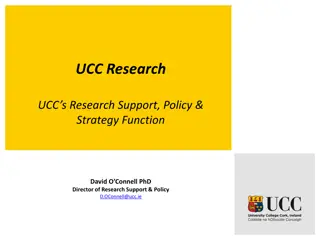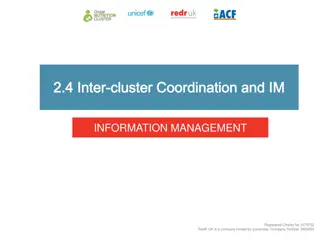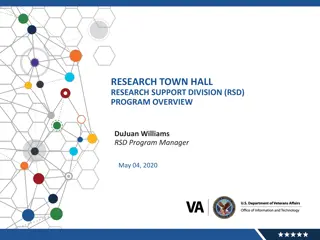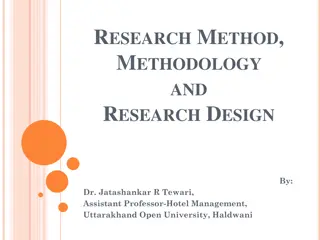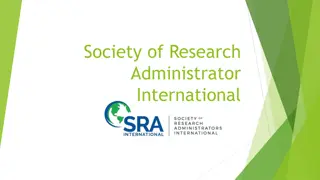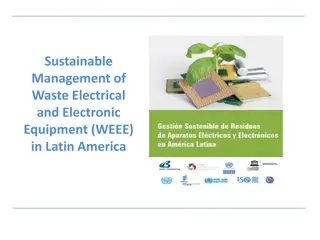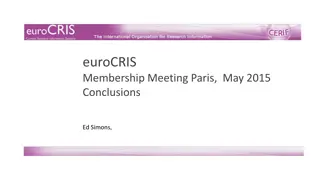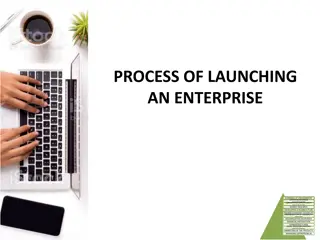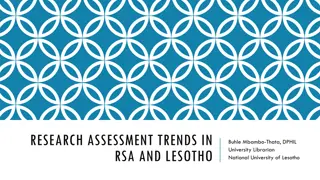Challenges and Opportunities in Research Information Management
Understanding the need for interoperability between Research Information Systems (CRIS) and Open Access Repositories (OAR) can enhance efficiency and quality of services for researchers. Collaboration is key to avoiding redundancies and maximizing the benefits for all stakeholders involved. Emphasizing commonalities and differences between CRIS and OAR helps in identifying areas where they can come together and deliver optimal research support.
Download Presentation

Please find below an Image/Link to download the presentation.
The content on the website is provided AS IS for your information and personal use only. It may not be sold, licensed, or shared on other websites without obtaining consent from the author. Download presentation by click this link. If you encounter any issues during the download, it is possible that the publisher has removed the file from their server.
E N D
Presentation Transcript
Repositories for research information management Wolfram Horstmann CERIF-CRIS and Repositories, Brussels, 12/13-oct-2011
The challenge http://mhpbooks.com/mobylives/?p=33681 Collaboration of researchers, administration & librarians!
Why CRIS & OA-Repositories? Given their affinity, achieving interoperability between CRIS and OAR is desirable and will benefit all parties involved, including the researchers. A joint approach will avoid double input and management of redundant data as well as redundant services and processes and will both enhance the efficiency and quality (mutual enrichment) of the services offered by CRIS and OAR to their users. January 2007: Knowledge Exchange DEFF, DFG, JISC, SURF Exchanging Research Information -- Razum, Simons & Horstmann [>> Text]
The Task There is still an assumed competition between CRIS and OARs and many other institutional systems CRIS and OARs should join forces to deliver the best possible services An account of Who does what and how? should be developed
Delineation: Characteristics Current Research Information Systems CRIS administrative, sensitive, comprehensive, integrative, local, analytic | administrators Open Access Repositories OAR public, file-centric, rights, preservation, globally distributed paradigm | librarians Bibliography Management System BMS CV oriented, complete, representative | researchers
Delineation: Commonalities Bibliographic Information Title, Source, Subject, Keywords, Rights, Authorship Affiliation Author Identity, Institute, Organisational Unit, Research Group, Time Frame Project Information short-term affiliation Time Frame, Funder, Participants, Budgets
Delineation: Differences CRIS more local, while OARs distributed CRIS: Financial information Budgets of projects, staff CRIS: Staff information Employment details, costs OAR: Full-Text Management Access Rights, Identifiers, Preservation, Compound Objects / Research Data
System Habitat CRIS and OAR potentially Financial System Human Resource Management Facility Management System Campus Management System Bibliographic Databases WoS, Scopus, ArXiV, PMC, IRs/BASE Authoritative Data Resources /Disambiguation Vocabularies, Ontologies, ORCID/AuthorClaim Massive common interoperability requirements
Species CRIS proper CERIF-centric: self or METIS, PURE, CONVERIS Integrating with institutional HRM, project & financial systems OAR proper DCES , MODS etc | DSPACE, E-Prints, Fedora BMS intermediates Proprietary, MODS: DSPACE, E-Prints, Invenio, LUP, etc. Aggregative Approaches Sharing and re-using resources
A CRIS AVEDAS AG, CONVERIS SYSTEM
An OAR ePrints Southhampton
Further Trends in OARs Extension towards BMS / Reporting Demand for authoritative resources increases Usage of vocabularies, ontologies, e.g. SPAR Usage of web services, linked data Personal displays, CV-Systems Extension towards Research Data Demand for collaboration with researchers incresases Repositories as embedded systems local and global integration
Research Data & Enhanced Publications http://www.ukpmc.co.uk
Semantic Web Approaches OpenAIRE and KE CRIS-OAR Interoperability Project
Interim Conclusion Neither CRIS nor OARs are autonomous Rather open, interrelated data mgmt. systems Any individual solution will be different Depending on the local system habitat Systems level not the correct approach? Rather consider human curation responsibilities
Curation processes Persons e.g. Human resource office, IT department (IDM) Finance e.g. Finance office Units e.g. Facility/Campus Management Projects e.g. Research office, Researchers Bibliographic Information e.g. Library, Researchers
The curation view on CRIS & OARs Treatment of systems as curation tools maintained by specialists Research project manager, financial officer, staff manager, bibliography specialist, data librarian, web content manager, identity manager, analyst No requirement to build integrated IT- columns Rather distributed systems view Reporting as distributed queries with display Data model may differ in systems, while entities, properties and vocabularies are aligned to interoperate on the aggregation/reporting level
Conclusion Convergence between CRIS and OAR both head towards aggregative systems OARs become sensitive e.g. Bibliometrics, Research Data CRIS become public e.g. CV displays, full-text Differences there to stay Administrators as end-users for CRIS Open Access as committment for OARs Research Information Repository / CRISpository already a reality
Recommendations Put the researcher in the centre CRIS & OARs have joint responsibility to serve research Even assessment exercises will only be accepted if the researchers agree on the approach taken Researchers are not interested in technicalities Regard CRIS and OARs as assemblies of specialized data curation activities Everybody should keep on doing what he/she can do best Systems and formats are slave to curation requirements Inter-departmental collaboration is the clue (and main challenge) Codex: Nobody will take away responsibility of the other
And yes CERIF will be the common demoninator











